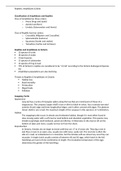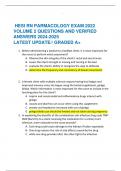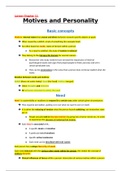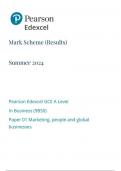The evolutionary functions of memory arre to understand our present situation, recognize and solve
problems posed by that situaion, anticipate the future, and make plans that will help us prepare for
and in some ways alter that future for our own (or our genes’) well-being.
Helps us to understand and deal adaptively with the present and the future.
Reasoning = the processes by which we use our memories in the abovementioned adaptive ways.
Intelligence = our general capacity to reason.
How People Reason 1: Analogies and Induction
We perceieve similarities among events we have experienced in order to make sense of present
experiences or to plan for the future.
Two kinds of reasoning that depend explicitly on idenfying similarities:
Analgocial reasoning;
Inductive reasoning.
Analgies as Foundations for Reasoning
Analogy (general definition) = any perceived similarity between otherwise different objects, actions,
events, or situations.
Analogy (restricted, psychologists’ definition) = a similarity in behaviour, function, or relationship
between entities or situations that are in other respects, such as in their physical makeup, quite
different from each other.
E.g. baseball glove is analogous to butterfly net: both used for capturing some category of
objects and both have a funnel-like shape that is useful for carrying out their function.
One type of analogical reasoning: A: B :: C: ?.
o E.g.: man is to woman as boy is to ? – answer is girl.
Use of Analogies in Scientific Reasoning
Kevin Dunbar (1999) found that biologists use analogies regularly to make sense of new findings and
to generate new hypotheses: they used 2 to 14 different analogies per hour.
Analytical thinking not only provides scientists with analogies to assist their understanding of the
natural world, but is also associated with a more skeptical, scientific view of the world in general,
even for nonscientists.
Use of Analogies in Judicial and Political Reasoning and Persuasion
Analogies are frequently used to convince others of some claim or course of action they support.
University students are good at generating analogies to defend political viewpoints.
Analogies can be misleading to the dgree that the relationships between the events do not hold true.
Analogical reasoning is only useful to the degree that the structural relationships in the analogy hold
true.
,Neurological Basis of Analogical Reasoning
The prefrontal cortex is involved in analogical reasoning. Analogical reasoning calls upon multiple
prefrontal brain areas
Extensive training in analogical reasoning results in changes in the distribution of white matter
connecting frontal cortices and in the frontal and parietal lobes. Greater white-matter changes were
also displayed in some parts of the brain.
This shows that analogical reasoning involves brain areas involved in the integration of information.
At least some aspects of analogical reasoning develop early (at least 6 yo), with experience altering
both cognition and underlying brain structures with age.
Young children's ability to engage in analogical reasoning and the effects that practice can have on
both how well one reasons and on the underlying brain structures suggest that formal instruction in
analogical reasoning could provide substantial educational benefits. Vendetti et al. (2015) suggested
several things that educators can do to support students in making analogical comparisons:
1. Provide students with opportunities to make comparisons between newly learned concepts
and previously learned ones.
2. Present source and target analogies simultaneously so that the student may visualize ways in
which they are related.
3. Provide additional cues, such as gestures, that move between the two contexts being
compared in order to highlight analogical mappings.
4. Highlight both the similarities and differences between sources and targets. If the difference
can lead to an incorrect inference, indicate explicitly where the analogy “breaks down”.
5. Use relational language to facilitate attention to shared relationships.
Inductive Reasoning and Some Biases in It
Inductive reasoning (induction) = the attempt to infer some new principle or proposition from
observations or facts that serve as clues.
Also called hypothesis construction: the inferred proposition is at best an educated guess, not
a necessary conclusion from the available evidence.
In general, inductive reasoning is reasoning that is founded on perceived analogies or other
similarities. The evidence from which one induces a conclusion is, ultimately, a set of past
experiences that are in some way similar to one another or to the experience one is trying to
explain or predict.
Systematic biases in our reasoning:
Availability bias: we tend to rely too strongly on information that is readiliy available to us
and ignore information that is less available.
o E.g., when asked to estimate percentage of people who die from various causes, the
percentages of causes that are often covered by the media are overestimated.
o E.g. misdiagnose a patient with a disease that a doctor has in mind more than other
diseases.
Confirmation bias: people tend to try to confirm rather than disconfirm their current
hypothesis.
o E.g. ask question on which a yes confirms the hypothesis, instead of asking questions
to find out if the hypothesis can be disproven.
, The predictable-world bias: we are so strongly predisposed to find order in our world that
we are inclined to “see” or anticipate order even where it doesn’t exist. It is, in essence, a
tendency to engage in inductive reasoning even in situations where such reasoning is
pointless because the relationship in question is completely random.
o Superstitions often arise because people fail to realize that coincidences are often
just coincidences.
o E.g. a man thinks his green shirt is his “lucky shirt” because some great even
happened once when he was wearing it.
o E.g. gamblers who see patterns in results.
How People Reason 2: Deduction and Insight
Deductive reasoning = the attempt to derive logically the consequences that must be true if certain
premises are accepted as true.
Logical proof, assuming the premises are true.
Deductive problems:
Series problem = requires one to organize items into a series on the basis of a set of
comparison statements and then arrive at a conclusion that was not contained in any single
statement.
Syllogism = presents a major premise, or proposition, and a minor premise that you must
combine mentally to see if a particular conclusion is true, false or indeterminate.
The Concrete Nature of Deductive Reasoning
People are better at solving deductive problems by reflecting on our real world knowledge, not by
thinking about laws of logic.
Deductive Problems: Logic or Content?
The content of (structurally the same) deductive problems will influence the amount of people
getting it right. If it’s abstract it’s less likely that someone gets it right than if it has logical real-world
content.
The bias for using knowledge rather than formal logic in answering deductive reasoning questions
can be construed as a bias for thinking inductively rather than deductively. Our natural tendency is to
reason by comparing the current information with our previous experience, and, outside the
mathematics classroom or psy chology experiment on logic, that tendency generally serves us well.
Part of the skill in solving problems that contradict our knowledge gained from past experience lies in
our ability or willingness to suppress that knowledge.
Elements of Insight
Insight problems = problems that are specially designed to be unsolvable until one looks at them in a
way that is different from the usual way.
Often entail a mix of inductive and deductive reasoning.
Breaking Out of a Mental Set: Broadening Perception and Thought
Mental set = a well-established habit of perception or thought.
, Insight problems tend to be difficult because their solution depends on abandoning a mental
set.
Functional Fixedness and Tools: A Special Case?
Functional fixedness = the failure to see an object as having a function other than its usual one (a
type of mental set).
Often seen in a negative light, reflecting a lack of creativity and flexible thinking.
Knowing what a tool is “for” and using it exclusively for that purpose does, however, provide
the user increased efficiency since one uses it without having to think about how to use it.
Tools are manufactured by perople for a specific purpose.
Design stance: people readily assume that tools are designed for an intended function.
o E.g. forks for eating, axes for chopping.
Design stance may be an adaptation:
It is seen early in development: even infants develop categories for tools and tend to use
tools in the conventional ways.
It is not found in other tool-using animals.
o Chimps, bonobos, gorillas and monkeys use tools in the most effective ways,
regardless of prior experience with it. Thus, they use them more flexibly.
Unconscious Mental Processes May Lead to Insight
The mental capacities required for solving insight problems are different from those required for
deductive reasoning.
Incubation period = some time off from a problem, in order to come back to it later and then solve it.
Assumption is that during incubation the person is unconsciously reorganizing the material
related to the problem while consciously reorganizing the material related to the problem
while consciously doing and thinking about other things.
Facilitates insight, but does not help in deduction.
o Deduction requires conscious attention; slow thinking.
o Thus, unconscious, “fast” mental processes are more important for solving insight
problems than for solving deductive problems.
o “Priming” (the activation of a mental concept to a level that does not reach
consciousness, but nevertheless makes that concept more available for forming
connections to other concepts) is likely involved in insight.
The Value of a Happy, Playful Frame of Mind
People are better at solving insight problems if they feel happy.
Studies have shown that a happy mood improves creativity and the ability to see whole
patterns in tests of visual perception.
Broaden-and-build theory of positive emotions = Negative emotions tend to narrow one’s focus of
perception and thought, which leads to focusing only on specific emotion-evoking objects and on
routine, well-learned ways of responding. In contrast, positive emotions broaden one’s scope of
perception and thought and increase creativity.
, May be adaptive: moment of emergency is not suited to test creative ideas. Positive
emotions are felt when there is no danger and one’s immediate biological needs are
relatively well satisfied – that is the time to think creatively and come up with new ideas and
ways of dealing with the world.
Perhaps not positive emotions per se but the feeling of playfulness is confucive to learning
and creativity.
Cross-Cultural Differences in Perception and Reasoning
Responses of Unschooled Non-Westerners to Western-Style Logic Questions
The way people approach tests – their understanding of what is expected of them – is culturally
dependent.
Non-Westerners often find it absurd or presumptuous to respond to questions outside their
realm of experiences.
Non-Westerners are more likely to answer logic questions in practical, functional terms
rather than in terms of abstract properties.
Differences in reasoning may be more of preference than of ability.
An East-West Difference: Focus on Wholes Versus Parts
East Asians perceive and reason more holistically and less analytically than Westerners.
E.g. when asked to describe a scene they’d been shown, Japanese students generally made
more complete descriptions, while American students focused more on specific parts of the
scene. The Japanese were also more likely to recall the relationships among the various
elements of the scene. On the other hand, Americans were more likely to recognize objects
apart from the scene, against a different background, than the Japanese.
This cross-national pattern is found as early as at 6yo.
Studies suggest that children over the world begin life with a more holistic bias, but
depending on cultural practices, some become more socialized to focus their attention, while
others become socialized to divide their attention.
The holistic attention to background, context and interrelationships helps to reason differently from
the ways Westerners do:
East Asians mention contextual forces that provoke behaviour more often than Americans.
Americans talk more often about internal attributes of the behaving individual, such as
motivation or personality.
The cultural differences are not a result of genetic differences: East Asians who have migrated to
North America think more like other Americans.
Possibly due to philosophical differences that underlie the cultures.
The Practice and Theory of Intelligence Testing
Intelligence = ability to reason, solve problems, and acquiring new knowledge.
A Brief History of Intelligence Testing
Modern intelligence tests have their ancestry in the Binet-Simon Intelligence Scale, which was
developed to determine children’s intelligence in order to identify who were not profiting as much as
,they should from their schooling so they might be given special attention. Thus, it was mostly aimed
at skills required for schoolwork.
First intelligence test commonly used in North America was the Stanford-Binet Scale, a modification
of the above.
Most widely used today are descendants of a test developed by David Wechsler: the Wechsler Adult
Intelligence Scale, Fourth Edition (WAIS-IV), the Wechsler Intelligence Scale for Children, Fourth
Edition (WISC-IV), and the Wechsler Preschool and Primary Scale of Intelligence, Fourth Edition
(WPPSI-IV) for children 2 to 7 yo.
WAIS-IV consists of subtests in four categories:
Verbal comprehension: provides an index of verbal abilities. Includes three core subtests:
o Vocabulary;
o Similarities: the ability to explain how similar concepts are alike;
o Information: general knowledge and general understanding of the social and physical
world.
Perceptual processing: focus on spatial and quantitative reasoning. Includes the following
core subtests:
o Block design: ability to maych visual designs;
o Matrix reasoning;
o Visual puzzles: assesses the ability to detect and combine visual patterns.
Working memory: inlcudes two core subtests:
o Digit span: the number of randomly presented digits that can be remembered in a
row;
o Artithmetic: subjects must concentrate while manipulating mental mathematical
problems.
Processing speed: two core subtests:
o Symbol search: the ability to spot target symbols quickly in arrays of visual symbols;
o Digit-Symbol Coding: ability to transfrom digits according to the rules of a code.
IQ-score = individual’s raw score on intelligence test, relative to normative data made up of results
obtained from large samples of individuals who have already taken the test.
Average = 100.
Overall distribution of scores fits the bell-shaped curve known as normal distribution.
The Validity of Intelligence Tests as Predictors of Achievement
IQ validity is assessed by researchers in terms of the tests’ abilities to predict success in school and
careers.
IQ scores correlate moderately well with grades in school (r 0.3 to 0.7).
People with higher IQ scores are much more likely than those with lower scores to gain
employment in intellectually demanding occupations such as medicine, law, science, and
business management.
o Coutns also for people who were raised in similar environments.
Moderate positive correlation between IQ and on-the-job performance.
o The correlation is higher for jobs that require a great deal of judgement and
reasoning, i.e. that are in the high-mental-complexity category.
, IQ scores are positively related to better physical and mental health, fewer non-intentional
and intentional injuries, and a lower incidence of late-onset dementia, as well as with
longevity.
o Also true for people who were similar in education and socioeconomic status.
o Counts also other way around: IQ is correlated negatively with alocoholism, smoking,
obesity, and traffic accidents.
The Concept of General Intelligence and Attempts to Explain It
General Intelligence (g)
Positive manifold = people who score high on one mental test also, on average, tend to score high on
all other tests.
Correlations typically in the range of 0.3 to 0.6.
Every mental test, thus, mesures some common factor, more or less well. This is labeled g,
for general intelligence.
General intelligence (g) = the underlying ability that contributes to a person’s performance on all
mental tests.
Best measures of g are derived from averaging the scores on many diverse mental tests.
o Same logic lies behind the use of many subtests in standard intelligence, such as the
WAIS-IV, to determine IQ.
Fluid Intelligence and Crystallized Intelligence
Cattell (1971) proposed that g is divisible into two separate gs:
Fluid intelligence = the ability to perceive relationships among stimuli independently of
previous specific practice or instruction concerning those relationships.
o Best measures by tests where people identify similarities and differences between
stimulus items that they have never previously experienced, or between items so
common that eveeryone in the tested population would have experienced them.
o Fluid abilities are biologically determined and reflected by tests of memory span,
speed of processing, and spacial thinking.
o Typically peaks at age 20-25.
Crystallized intelligence = mental ability derived directly from previous experience.
o Best assessed in tests of knowledge, such as knowledge of word meanings, cultural
practices, and how particular tools or instruments work.
o One’s accumulated knowledge can be applied broadly to solve a wide variety of
problems.
o Typically peaks at about 50 or later.
Cattell argues that fluid and crystallized intelligence are distinct, but not entirely independent. The
scores of both correlate positively. This is, he suggested, because people with higher fluid intelligence
learn and remember more from their experiences than people with lower fluid intelligence.
Therefore, crystallized intelligence depends on fluid intelligence.
Fluid and crystallized heritability are about equally heritable.
, Mental Speed as a Possible Basis for g
There exist modest correlations (between -0.3 and -0.5) between speed of responding and
intelligence, with faster responding (thus, presumably faster information processing) being
associated with higher IQ.
Inspection time = measure of mental speed which entails the minimal time that subjects need to look
at or listen to a pair of stimuli to detect the difference between them.
Correlation between inspection time and IQ is about 0.3 for fluid intelligence and 0.2 for crystallized
intelligence.
Executive Functions as a Possible Basis for g
The three components of executive functions (working memory, switching, and inhibition) have been
hypothesized to underlie g.
Information fades quickly from working emmory when it is not being acted upon, so the faster you
can process information, the more items you can maintain in working memory at any given time.
Consistent with this idea, correlations are high between measures of mental speed and working
memory, and this could be why mental speed correlates positively with fluid intelligence.
Working memory span is a good predictor of academic performance, and is a better predictor of
cognitive abilites than simple memory-span measures.
People with different levels of intellecutal attainment differ in executive functions:
People with intellectual impairment perform more poorly on executive-function tasks.
Ability to self-regulate emotions and behaviour is predictor of academic performance.
Thus, people who perform well on intelligence tests are those who can control their mental
resources in a way that allows for efficiency in problem solving. One must remain focused, avoid
distraction, and distinguish between relevant and irrelevant information.
General Intelligence as an Evolutionary Adaptation for Novelty
From an evolutionary perspective, general intelligence evolved as a means of solving problems that
are evolutionarily novel. People, more than other creatures, are capable of dealing effectively with a
wide range of environmental conditions, including conditions that were never regularly faced by our
evolutionary ancestors.











